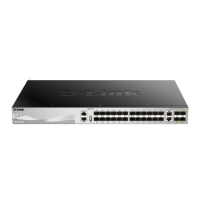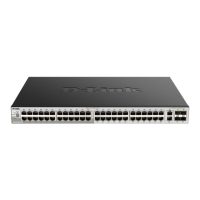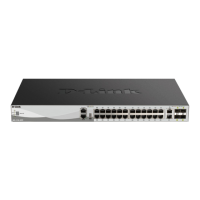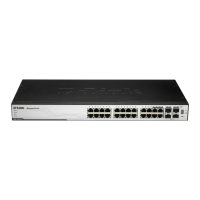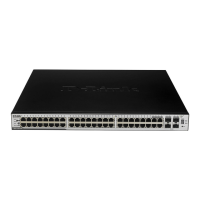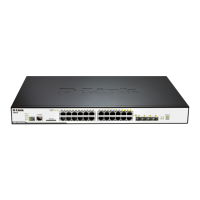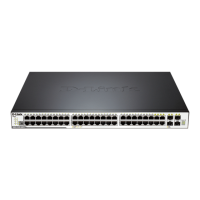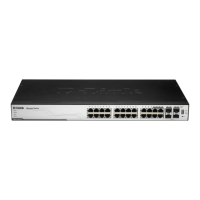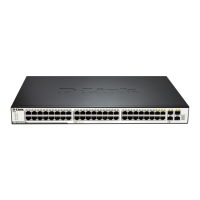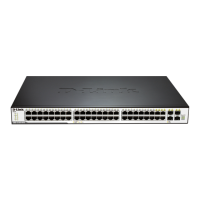Do you have a question about the D-Link DGS-3130 Series and is the answer not in the manual?
Explains the Web UI's function for accessing configuration, viewing statistics, and graphical monitoring.
Covers settings for physical ports, including speed, duplex, MDIX, and flow control.
Details Power over Ethernet (PoE) features, including auto-discovery, auto-disable, and active circuit protection.
Allows creation, updating, and viewing of active user account sessions, with options depending on Privilege Level.
Manages Dynamic Host Configuration Protocol (DHCP) settings, including service, class, server, and relay configurations.
Covers stacking configurations, including physical stacking, stacking bandwidth, and virtual stacking (SIM).
Provides functions for saving configuration, firmware upgrades, backups, and system utilities like Ping and Trace Route.
Covers VLAN configurations, including 802.1Q, 802.1v Protocol VLAN, GVRP, Asymmetric VLAN, MAC VLAN, and VLAN Interface.
Configures Spanning Tree Protocol (STP) settings, including MSTP, RSTP, STP Global Settings, and STP Port Settings.
Covers multicast control features like IGMP Snooping, MLD Snooping, Multicast VLAN, and Multicast Filtering.
Manages Address Resolution Protocol (ARP) settings, including elevation, aging time, static ARP, and proxy ARP.
Manages Open Shortest Path First (OSPF) settings, including OSPFv2 and OSPFv3 processes, interfaces, and areas.
Covers basic QoS settings like Port Default CoS, Port Scheduler Method, and Queue Settings.
Includes advanced QoS configurations such as DSCP Mutation Map, Port Trust State, DSCP CoS Mapping, and Color Mapping.
Guides users through creating or updating ACL access lists, including packet type and rule addition.
Displays and configures ACLs, including access lists, rules, and settings.
Implements security by restricting unauthorized MAC addresses, with settings for global, VLAN, and port configurations.
Configures IEEE 802.1X for port-based and host-based access control using RADIUS authentication.
Configures global RADIUS settings, server settings, and group server settings for centralized authentication.
Manages TACACS+ server and group server settings for centralized authentication, authorization, and accounting.
Configures IP-MAC-Port Binding (IMPB) settings for IPv4 and IPv6 to restrict access based on address binding.
Configures ARP spoofing prevention settings to drop packets with mismatched MAC addresses or invalid IP addresses.
Configures BPDU attack protection settings, defining modes like Drop, Block, and Shutdown for ports.
Configures MAC authentication settings, allowing user authentication via MAC address using local database or RADIUS.
Manages Web-based Access Control (WAC) for authenticating users accessing the Internet via the Switch.
Configures network access authentication settings, including Guest VLAN and global settings.
Configures Connectivity Fault Management (CFM) settings, including global CFM settings and domain/MA configuration.
Configures Ethernet Operations, Administration, and Maintenance (OAM) settings for link monitoring and fault detection.
Performs Digital Diagnostic Monitoring (DDM) functions, including viewing status and configuring alarm/threshold settings.
Provides port and interface statistics, including counters for errors and history.
Manages firmware upgrades and backups using HTTP or TFTP servers.
Restores or backs up the switch configuration using HTTP or TFTP.
Details system log entries related to AAA state, successful/failed logins, and privilege changes.
Explains the Web UI's function for accessing configuration, viewing statistics, and graphical monitoring.
Covers settings for physical ports, including speed, duplex, MDIX, and flow control.
Details Power over Ethernet (PoE) features, including auto-discovery, auto-disable, and active circuit protection.
Allows creation, updating, and viewing of active user account sessions, with options depending on Privilege Level.
Manages Dynamic Host Configuration Protocol (DHCP) settings, including service, class, server, and relay configurations.
Covers stacking configurations, including physical stacking, stacking bandwidth, and virtual stacking (SIM).
Provides functions for saving configuration, firmware upgrades, backups, and system utilities like Ping and Trace Route.
Covers VLAN configurations, including 802.1Q, 802.1v Protocol VLAN, GVRP, Asymmetric VLAN, MAC VLAN, and VLAN Interface.
Configures Spanning Tree Protocol (STP) settings, including MSTP, RSTP, STP Global Settings, and STP Port Settings.
Covers multicast control features like IGMP Snooping, MLD Snooping, Multicast VLAN, and Multicast Filtering.
Manages Address Resolution Protocol (ARP) settings, including elevation, aging time, static ARP, and proxy ARP.
Manages Open Shortest Path First (OSPF) settings, including OSPFv2 and OSPFv3 processes, interfaces, and areas.
Covers basic QoS settings like Port Default CoS, Port Scheduler Method, and Queue Settings.
Includes advanced QoS configurations such as DSCP Mutation Map, Port Trust State, DSCP CoS Mapping, and Color Mapping.
Guides users through creating or updating ACL access lists, including packet type and rule addition.
Displays and configures ACLs, including access lists, rules, and settings.
Implements security by restricting unauthorized MAC addresses, with settings for global, VLAN, and port configurations.
Configures IEEE 802.1X for port-based and host-based access control using RADIUS authentication.
Configures global RADIUS settings, server settings, and group server settings for centralized authentication.
Manages TACACS+ server and group server settings for centralized authentication, authorization, and accounting.
Configures IP-MAC-Port Binding (IMPB) settings for IPv4 and IPv6 to restrict access based on address binding.
Configures ARP spoofing prevention settings to drop packets with mismatched MAC addresses or invalid IP addresses.
Configures BPDU attack protection settings, defining modes like Drop, Block, and Shutdown for ports.
Configures MAC authentication settings, allowing user authentication via MAC address using local database or RADIUS.
Manages Web-based Access Control (WAC) for authenticating users accessing the Internet via the Switch.
Configures network access authentication settings, including Guest VLAN and global settings.
Configures Connectivity Fault Management (CFM) settings, including global CFM settings and domain/MA configuration.
Configures Ethernet Operations, Administration, and Maintenance (OAM) settings for link monitoring and fault detection.
Performs Digital Diagnostic Monitoring (DDM) functions, including viewing status and configuring alarm/threshold settings.
Provides port and interface statistics, including counters for errors and history.
Manages firmware upgrades and backups using HTTP or TFTP servers.
Restores or backs up the switch configuration using HTTP or TFTP.
Details system log entries related to AAA state, successful/failed logins, and privilege changes.
| Category | Switch |
|---|---|
| Managed | Yes |
| L3 | Yes |
| Ports | 48 x 10/100/1000BASE-T |
| Stacking Ports | 2 x 10G SFP+ |
| Operating Temperature | 0°C to 50°C |
| Storage Temperature | -40°C to 70°C |
| Standards Compliance | IEEE 802.3, IEEE 802.3u, IEEE 802.3ab, IEEE 802.3z, IEEE 802.3x, IEEE 802.1D, IEEE 802.1w, IEEE 802.1s, IEEE 802.1Q, IEEE 802.1p, IEEE 802.3ad, IEEE 802.1X |
| Series | DGS-3130 Series |
| VLANs | 4094 |

